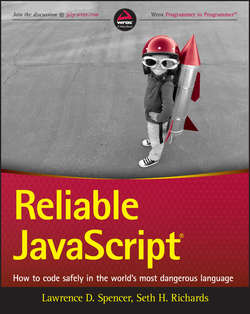Читать книгу Reliable JavaScript - Lawrence Spencer - Страница 9
На сайте Литреса книга снята с продажи.
INTRODUCTION
THE RISE OF JAVASCRIPT AS A FIRST-CLASS LANGUAGE
ОглавлениеJavaScript's reputation as a wild child is well-deserved, and we hope to amuse you with some of its exploits in the next two sections. However, like a spoiled heiress who inherits the family business and surprises everyone by rising to the challenge, she has turned serious and responsible, lately showing herself capable of true greatness.
Her early life was as a dilettante, rarely entrusted with anything more than short “scripting” tasks. The decisions she made were simple: If a required field was not filled in, she should color it red; if a button was clicked, she should bring another page into view. Although her responsibilities were limited, she was easy to get along with and made many friends. To this day, most programmers' experience of her is primarily of this sort.
Then, in the shift that was to redefine her life, the world turned to the web. This had been her playground, her little place to amuse herself while members of The Old Boys Club did the real work on the server.
The wave started to break in the late 1990s when Microsoft introduced first iframes and then XMLHTTP. When Google made Ajax part of its Gmail application in 2004 and Google Maps in 2005, the wave came crashing down. The world was suddenly aware of just how much richer the web experience could be when the browser was entrusted with more than just displaying whatever the server dispensed.
So it was that our princess was given more responsibility than anyone had ever intended. She would need help.
And help did come, in the form of toolkits and frameworks like jQuery, Ext JS, Ember.js, Knockout, Backbone, and AngularJS. These worthy advisors did everything they could to bring discipline and structure to JavaScript. However, they never quite tamed her youthful exuberance. In spite of her advisors and her good intentions, she was always getting into trouble.
